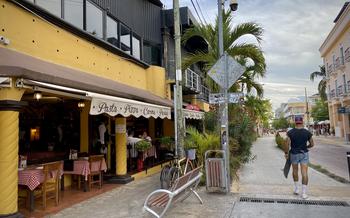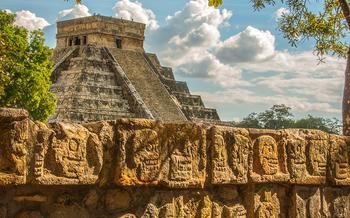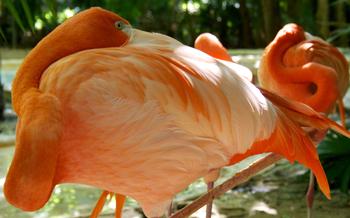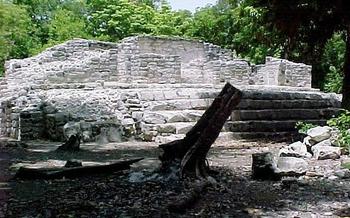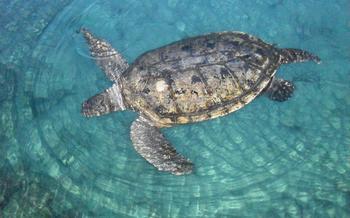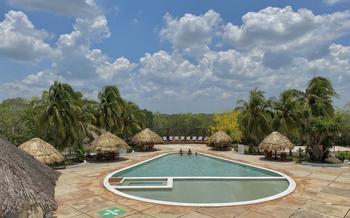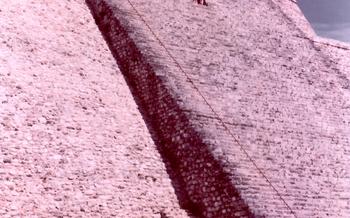
Coba Ruins
- Coba Ruins: A Journey to the Past
- Exploring the Archaeological Zone
- Climbing the Nohoch Mul Pyramid: Reaching New Heights
- Discover the Ball Courts
- Walk or Bike through the Jungle
- Visit the Coba Cenote: A Refreshing Oasis in the Mayan Jungle
- Uncover the Stelae of Coba
- Immerse Yourself in Mayan Culture
- Embrace Eco-friendly Tourism
- Plan Your Visit Wisely
- Dress for the Occasion
- Hydration and Snacks
- Capture the Memories
- Insider Tip: Discover the Hidden Gems
Coba Ruins: A Journey to the Past
The Coba Ruins, nestled in the heart of the Yucatan Peninsula, Mexico, transport visitors to the ancient Mayan civilization's glorious era. Once a thriving metropolis, Coba played a crucial role in the Mayan world, serving as a political, economic, and religious center. Today, the ruins stand as a testament to the architectural prowess and cultural heritage of this enigmatic civilization.
Located approximately 40 miles northwest of Tulum, the Coba Ruins offer easy accessibility for travelers seeking to delve into the depths of Mayan history. The site is well-connected by road, making it a convenient destination for those exploring the Riviera Maya region. As you approach the ruins, you will be struck by their sheer size and grandeur, hinting at the significance they once held in the Mayan world.
Exploring the Archaeological Zone
The Coba Ruins encompass an extensive archaeological zone, showcasing the grandeur and complexity of the ancient Mayan civilization. As you enter the site, you'll be greeted by a network of well-preserved sacbeob, or raised pathways, leading you through the lush jungle. These pathways connect the various structures and plazas, creating a sense of order and organization that characterized Mayan urban planning.
One of the most striking features of Coba is its sheer size. The site covers an area of approximately 70 square kilometers, making it one of the largest Maya cities ever discovered. This vastness adds to the sense of awe and wonder as you explore the ruins, uncovering the secrets of a civilization that thrived centuries ago.
As you wander through the archaeological zone, you'll encounter a variety of structures, each serving a distinct purpose in the life of the Maya. Temples, palaces, residential buildings, and workshops line the sacbeob, providing a glimpse into the daily lives of the ancient inhabitants.
The most prominent structure at Coba is the Nohoch Mul Pyramid, which dominates the skyline with its imposing height. This towering pyramid, also known as the Great Pyramid, is a testament to the architectural prowess of the Maya and offers breathtaking views of the surrounding jungle.
Other notable temples and buildings include the Templo de las Pinturas (Temple of the Paintings), which features well-preserved murals depicting Mayan life and rituals; the Iglesia (Church), a Spanish colonial structure built atop a Mayan temple; and the Grupo de las Estelas (Group of the Stelae), which houses a collection of intricately carved stone monuments.
Exploring the archaeological zone of Coba is an immersive journey through time, allowing you to trace the footsteps of the ancient Maya and gain a deeper understanding of their rich culture and history.
Climbing the Nohoch Mul Pyramid: Reaching New Heights
Ascending the grand Nohoch Mul Pyramid is an exhilarating experience that rewards adventurers with breathtaking panoramas and a sense of accomplishment. However, safety must always come first. Before embarking on this climb, ensure that you are physically fit and wear appropriate footwear with good traction. The climb involves steep steps and uneven surfaces, making it crucial to proceed with caution and at your own pace.
As you ascend, take breaks to catch your breath and admire the stunning views that gradually unfold before you. The lush jungle canopy stretches out in all directions, dotted with ancient temples and structures that hint at the grandeur of the once-mighty Maya civilization.
To make the most of your climb, consider these additional tips:
- Start early in the morning or late in the afternoon to avoid the midday heat and crowds.
- Bring plenty of water to stay hydrated, especially if visiting during the hot and humid summer months.
- Be mindful of your surroundings and watch your footing, as the steps can be slippery, especially after rainfall.
- Take frequent breaks to rest and enjoy the views from different vantage points.
- Once you reach the top, take a moment to soak in the panoramic vistas and capture some memorable photographs.
- Descend carefully, using the handrails provided for support.
Conquering the Nohoch Mul Pyramid is an unforgettable experience that offers a unique perspective on the ancient Maya city of Coba. Embrace the challenge, climb safely, and revel in the awe-inspiring views that await you at the summit.
Discover the Ball Courts
The ancient Mayans were passionate about sports, and their ball games held deep cultural and religious significance. At Coba, you'll find several well-preserved ball courts, offering a glimpse into this fascinating aspect of Mayan life.
The ball courts at Coba are unique in their design and construction. Unlike other Mayan ball courts, which are typically long and narrow, the courts at Coba are almost square, with sloping sides and elevated playing surfaces. This unique design allowed for a more dynamic and fast-paced game.
Visiting the ball courts is an immersive experience that transports you back in time. Imagine the roar of the crowd as two teams of skilled players battled it out, using only their hips and elbows to propel the heavy rubber ball towards the stone hoops mounted high on the walls. The outcome of the game was believed to have spiritual and political implications, making it a high-stakes competition.
Today, you can wander through the ball courts, marveling at the intricate stonework and imagining the intensity of the games that once took place here. The courts are a testament to the skill and artistry of the Mayan people, and a reminder of the importance of sports and competition in their culture.
Walk or Bike through the Jungle
Beyond the main archaeological zone, Coba offers a unique opportunity to immerse yourself in the verdant jungle that surrounds the ruins. Designated trails and routes allow you to explore the lush vegetation, encounter diverse wildlife, and discover hidden cenotes. Whether you prefer a leisurely stroll or an exhilarating bike ride, the Coba jungle offers an unforgettable adventure.
For those who prefer to explore on two wheels, bike rental options are available near the entrance of the archaeological zone. Biking through the jungle trails offers a sense of freedom and allows you to cover more ground, making it an ideal option for those who want to venture deeper into the jungle.
Keep an eye out for the abundant wildlife that calls the Coba jungle home. Howler monkeys, spider monkeys, and various bird species can often be spotted swinging through the trees or soaring overhead. The jungle is also home to a variety of reptiles, including iguanas and snakes, so be sure to tread carefully and respect their natural habitat.
Visit the Coba Cenote: A Refreshing Oasis in the Mayan Jungle
Location and accessibility: Located just a short walk from the main ruins, the Coba Cenote is easily accessible and invites visitors to immerse themselves in its refreshing waters. Surrounded by lush vegetation and towering trees, the cenote offers a serene and tranquil ambiance, perfect for escaping the heat and crowds of the archaeological site.
Swimming and snorkeling opportunities: The Coba Cenote boasts crystal-clear waters, providing excellent visibility for swimming and snorkeling. Visitors can marvel at the intricate underwater world, teeming with diverse aquatic life, including colorful fish, turtles, and even the occasional crocodile. The cenote's refreshing waters offer a welcome reprieve from the tropical heat, making it a popular spot for cooling off and rejuvenating.
Facilities and amenities: To ensure a comfortable and enjoyable experience, the Coba Cenote is equipped with various facilities and amenities. Visitors can take advantage of changing rooms, showers, and restrooms, ensuring they can freshen up after their swim or snorkel. Additionally, there are designated areas for picnicking and relaxing, allowing visitors to unwind and soak in the natural beauty of the surroundings.
Uncover the Stelae of Coba
Coba is home to an impressive collection of stelae, intricately carved stone monuments that provide valuable insights into the history, culture, and beliefs of the ancient Maya. These stelae are scattered throughout the archaeological zone, each telling its own unique story.
The most notable stelae at Coba are Stelae 1 and Stelae 2, which depict scenes of warfare, royal ceremonies, and astronomical events. Stelae 1, in particular, is renowned for its intricate carvings and well-preserved inscriptions, which have provided researchers with valuable information about the dynastic history of Coba.
To fully appreciate the significance of the stelae, it's recommended to hire a local guide who can provide detailed explanations and historical context. These guides are knowledgeable about the Mayan culture and can help you decipher the intricate symbols and glyphs found on the stelae.
Exploring the stelae of Coba is like stepping back in time and gaining a glimpse into the lives and beliefs of the ancient Maya. It's an opportunity to connect with history and appreciate the cultural heritage of this fascinating civilization.
Immerse Yourself in Mayan Culture
Beyond the awe-inspiring ruins, Coba offers a vibrant immersion into the rich Mayan culture that once thrived here. Delve into the fascinating world of Mayan rituals and traditions, which have been preserved and passed down through generations. Discover the intricate art of Mayan weaving, witness traditional dance performances, and learn about the significance of ancient ceremonies still practiced today.
Stroll through the local markets and admire the colorful handicrafts and souvenirs created by skilled Mayan artisans. From intricate textiles to hand-carved wooden sculptures, these treasures offer a tangible connection to the region's cultural heritage. Support the local community by purchasing these unique items, contributing directly to the preservation of Mayan traditions.
Engage with the friendly Mayan people, who are eager to share their culture and stories with visitors. Take the opportunity to learn a few Mayan phrases, immerse yourself in their warm hospitality, and gain a deeper understanding of their way of life. This cultural exchange is an unforgettable aspect of a visit to Coba, leaving you with a lasting appreciation for the vibrant Mayan culture.
Embrace Eco-friendly Tourism
As a responsible traveler, it's crucial to embrace eco-friendly practices while visiting the Coba Ruins. The preservation of this ancient site and its surrounding environment is vital for future generations to enjoy.
Sustainable Practices at the Ruins: At Coba, initiatives are in place to ensure the site's sustainability. Controlled visitor numbers, responsible waste management, and educational programs for tourists promote conservation efforts.
Responsible Tour Operators: Choose tour operators that prioritize sustainability. Look for companies that support local communities, use eco-friendly transportation, and adhere to ethical guidelines.
Minimizing Environmental Impact: Minimize your impact by reducing single-use plastics, conserving water, and respecting the natural flora and fauna. Avoid disturbing wildlife and stay on designated trails to prevent erosion.
Plan Your Visit Wisely
Timing is everything when it comes to exploring the Coba Ruins. The best time to visit is during the shoulder seasons (May-June and September-October) when the weather is pleasant, and the crowds are smaller. The dry season (November-April) offers clear skies and moderate temperatures, but it can get quite hot and crowded. Avoid visiting during the rainy season (July-August) as heavy rainfall can make the trails slippery and muddy.
To avoid the worst of the crowds, aim to arrive early in the morning or late in the afternoon. The ruins open at 8:00 AM, so getting there early will allow you to beat the tour groups and have the place to yourself for a while. Alternatively, visiting in the late afternoon will provide a more relaxed atmosphere and beautiful sunset views.
Before you embark on your journey, make sure to pack the essentials. Comfortable walking shoes are a must, as you'll be doing a lot of walking and climbing. A hat, sunglasses, and sunscreen are essential for protection from the sun, and a bottle of water is crucial to stay hydrated. You may also want to bring a camera to capture the stunning scenery and memories.
Dress for the Occasion
When visiting the Coba Ruins, appropriate attire is essential for a comfortable and enjoyable experience. Opt for lightweight, breathable clothing that allows for freedom of movement. Shorts or pants that fall below the knee are recommended to protect your legs from insect bites and the sun's rays. Avoid wearing revealing or sheer clothing, as this may be considered disrespectful to the Mayan culture.
For footwear, choose sturdy walking shoes or hiking boots with good ankle support. The terrain at the ruins can be uneven and slippery, and you'll be doing a lot of walking and climbing. Flip-flops or sandals are not suitable for this type of environment.
Sun protection is a must in the tropical climate of Mexico. Apply sunscreen liberally and reapply throughout the day, especially if you're climbing the Nohoch Mul Pyramid. Wear a wide-brimmed hat to shield your face and neck from the sun's harsh rays. Sunglasses are also recommended to protect your eyes from the glare.
Remember that the Coba Ruins are an active archaeological site, so it's important to dress respectfully. Avoid wearing clothing with offensive or inappropriate slogans or images.
Hydration and Snacks
Maintaining hydration is crucial for a comfortable and enjoyable visit to the Coba Ruins. The hot and humid climate can lead to dehydration quickly, especially when exploring the ruins on foot or climbing the pyramids. Bring a reusable water bottle and fill it up at the water stations located throughout the archaeological zone. Alternatively, you can purchase bottled water from vendors near the entrance. It's also essential to stay energized, so pack some snacks to replenish your energy levels. Choose light and nutritious snacks like fruits, nuts, or energy bars that won't weigh you down during your exploration. Avoid sugary drinks and heavy meals, as they can cause discomfort and hinder your ability to enjoy your visit.
Capture the Memories
Preserving the memories of your Coba adventure through photography is a must. Capture the awe-inspiring scale of the Nohoch Mul Pyramid against the backdrop of the lush jungle. Document the intricate carvings on the stelae, whispering tales of ancient Mayan history. Don't miss the vibrant colors of the local flora and fauna, adding a touch of life to the ancient ruins.
Respect the sanctity of the ruins and the local culture by refraining from using flash photography, which can damage the delicate artwork. Ask permission before photographing local people, and always treat them with respect.
Share your Coba experiences with the world through social media, but do so responsibly. Tag the location accurately, provide informative captions, and use relevant hashtags. By sharing your photos and stories, you can inspire others to embark on their own journey of discovery at Coba.
Insider Tip: Discover the Hidden Gems
Coba is a vast archaeological site, and there's more to explore beyond the main attractions. Venture off the beaten path to uncover hidden gems that offer a unique glimpse into Mayan history and culture. Explore the smaller temples and structures scattered throughout the jungle, each with its own story to tell. Seek out the guidance of local guides who can lead you to these lesser-known spots and provide insights into their significance. These hidden gems offer a more intimate and authentic experience, allowing you to connect with the spirit of ancient Coba and create lasting memories.
